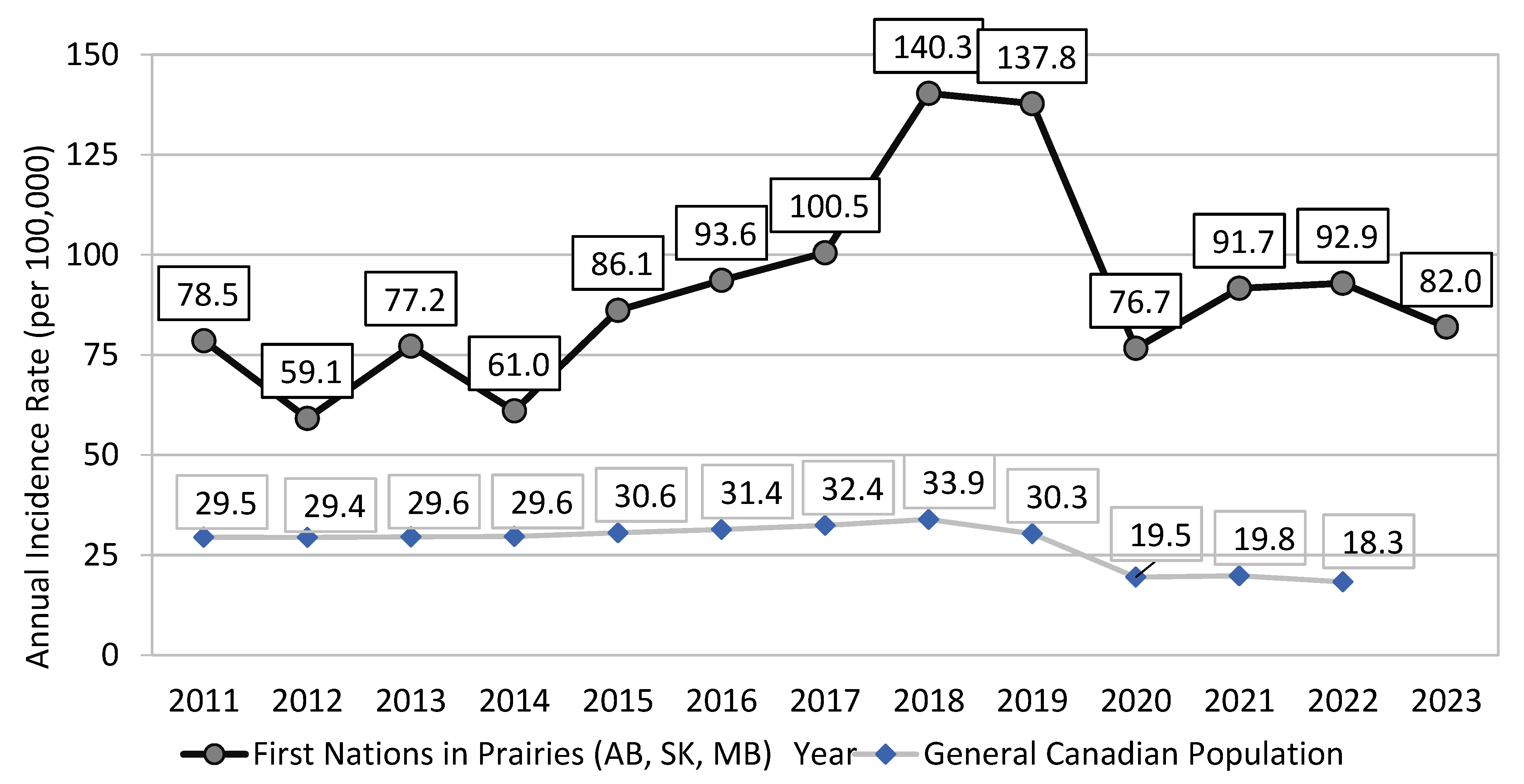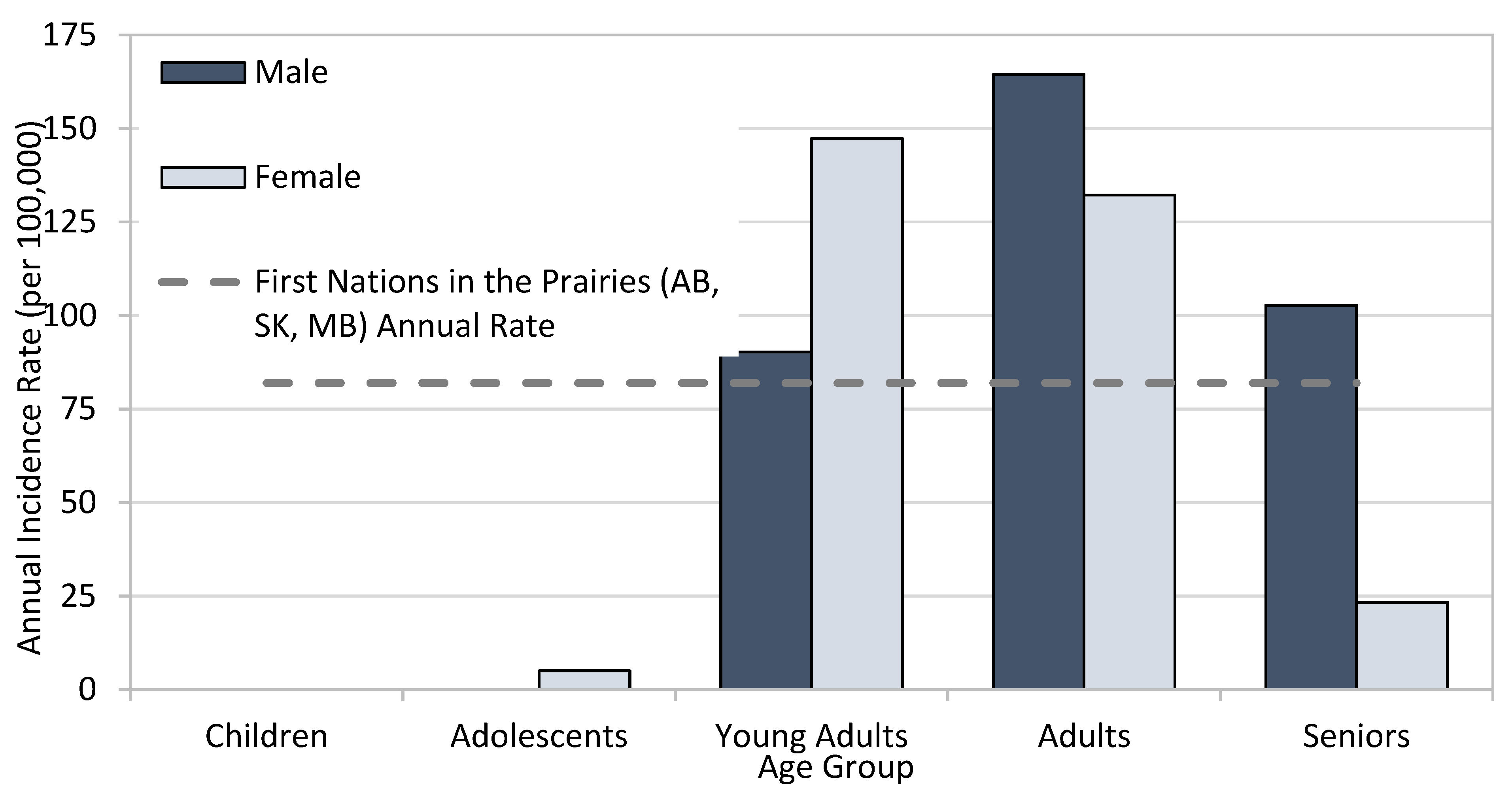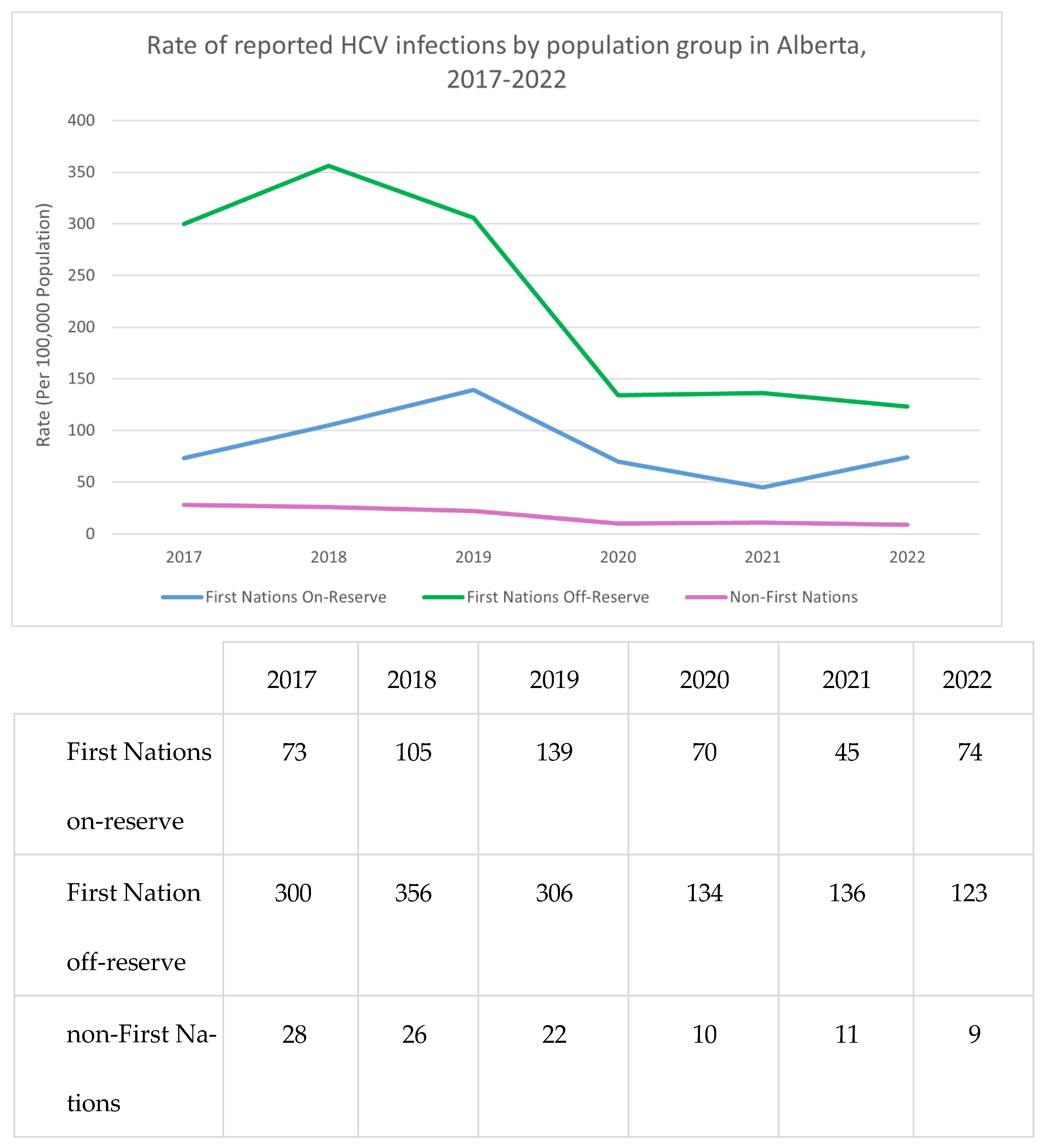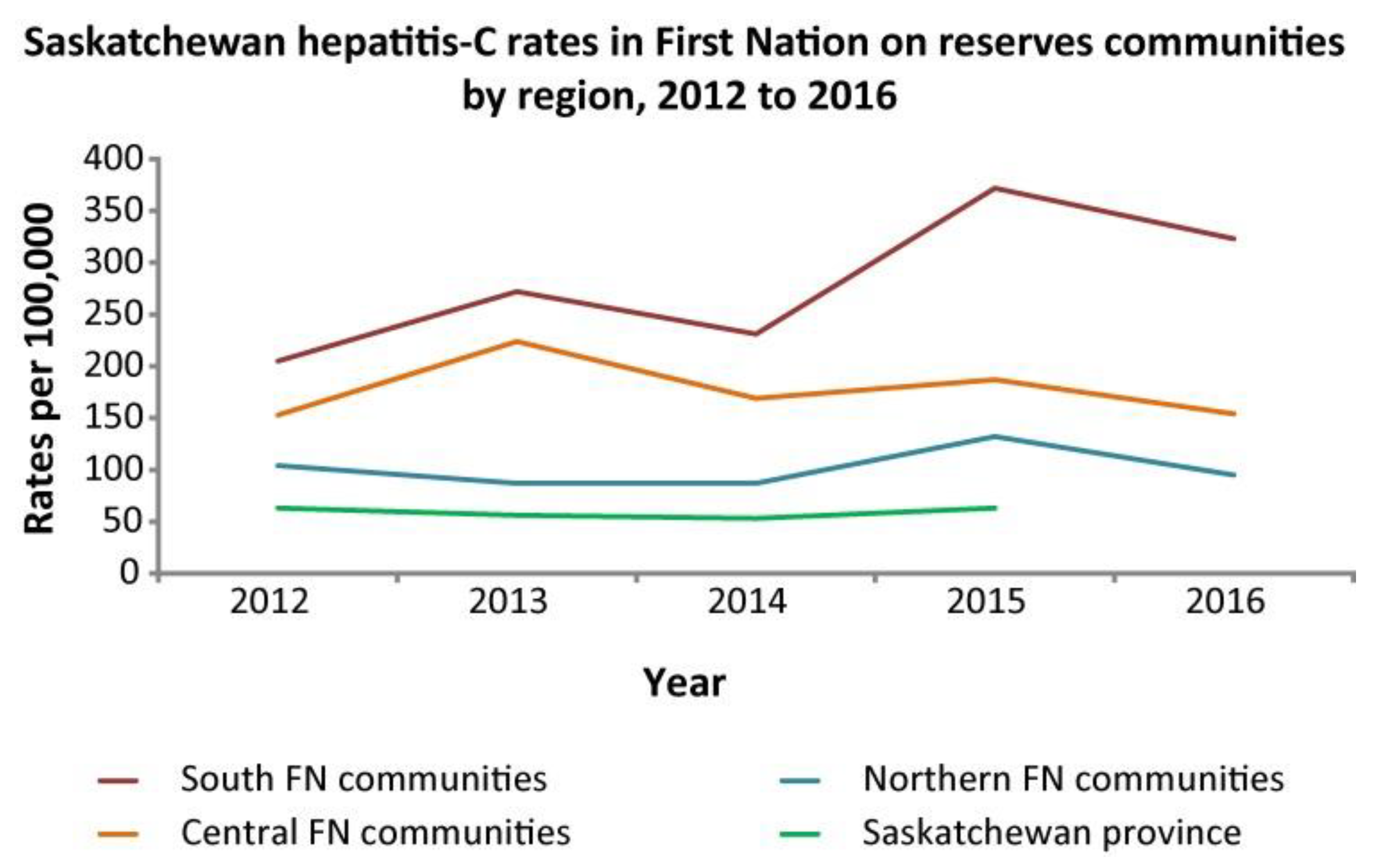Epidemiology of Chronic Hepatitis C in First Nations Populations in Canadian Prairie Provinces
Abstract
1. Introduction
2. Methodology
2.1. Hepatitis C Virus Infections in First Nations: A Historical Perspective on the Data Systems and Reported Outcomes
2.2. HCV Surveillance in First Nations in Canadian Prairies
2.3. Anti-HCV Status Awareness and Linkage to Care Among First Nations
2.4. Sources of HCV Surveillance Data and Data Limitations
2.5. The Colonial Legacy Link and Transmission of HCV
2.6. Access to Hepatitis C Testing and Treatment
2.7. Colonial Influence on the Experience of Hepatitis
2.8. Progress Toward HCV Elimination by 2030 in First Nations
2.9. Strategies for Change Through Promising Practice
3. Limitations
4. Conclusions
Supplementary Materials
Author Contributions
Funding
Institutional Review Board Statement
Informed Consent Statement
Data Availability Statement
Acknowledgments
Conflicts of Interest
Abbreviations
| DAA | Direct-acting antiviral |
| ECHO | Extension for community health outcomes |
| HCV | Hepatitis C virus |
| FN | First Nations |
| ISC | Indigenous Services Canada |
| PHAC | Public Health Agency of Canada |
| PWUD | Persons who use drugs |
| SVR | Sustained virological response |
| WHO | World Health Organization |
References
- Government of Canada. Statistics on Indigenous Peoples. 2019. Available online: https://www.statcan.gc.ca/en/subjects-start/indigenous_peoples (accessed on 9 July 2025).
- Greenwood, M.; de Leeuw, S.; Stout, R.; Larstone, R.; Sutherland, J. Introduction to Determinants of First Nation, Inuit and Métis Peoples’ Health in Canada; Canadian Scholars, an imprint of CSP Books Inc.: Toronto, ON, Canada, 2022. [Google Scholar]
- Joseph, J. Indigenous Relations: Insights, Tips and Suggestions to Make Reconciliation a Reality; Page Two Books Inc.: Vancouver, BC, Canada, 2019. [Google Scholar]
- World Economics. Canada|GDP|2021|Economic Data. Available online: https://www.worldeconomics.com/Country-Size/canada.aspx (accessed on 9 July 2025).
- Souissi, T. Systemic Racism in Canada|The Canadian Encyclopedia. 2022. Available online: https://www.thecanadianencyclopedia.ca/en/article/systemic-racism (accessed on 9 July 2025).
- Daniels v. Canada (Indian Affairs and Northern Development), 2016 SCC 12 (CanLII). Canlii.org. CanLII; 2016. Available online: https://www.canlii.org/en/ca/scc/doc/2016/2016scc12/2016scc12.html (accessed on 9 July 2025).
- Available online: https://s3.documentcloud.org/documents/2698184/Jugement.pdf (accessed on 9 July 2025).
- Available online: https://rapportspvm2019.ca/rapport/SPVM%20Stats_2019_ANG_FINAL.pdf (accessed on 9 July 2025).
- Government of Canada O of the AG of C. Report 4—Systemic Barriers—Correctional Service Canada. 2022. Available online: https://www.oag-bvg.gc.ca/internet/English/parl_oag_202205_04_e_44036.html (accessed on 9 July 2025).
- Over-representation of Indigenous persons in adult provincial custody, 2019/2020 and 2020/2021. Available online: https://www150.statcan.gc.ca/n1/pub/85-002-x/2023001/article/00004-eng.htm (accessed on 9 July 2025).
- Mcbride, K. Data Resources and Challenges for First Nations Communities Document Review and Position Paper Prepared for the Alberta First Nations Information Governance Centre. Available online: https://afnigc.ca/wp-content/uploads/2024/01/Data_Resources_Report.pdf (accessed on 9 July 2025).
- Available online: https://oci-bec.gc.ca/sites/default/files/2023-10/Annual%20Report%20EN%20%C3%94%C3%87%C3%B4%20Web.pdf (accessed on 9 July 2025).
- The Report of the Royal Commission on Aboriginal Peoples (PRB 99-24E). Available online: https://publications.gc.ca/Collection-R/LoPBdP/EB/prb9924-e.htm (accessed on 9 July 2025).
- Government of Canada. Truth and Reconciliation Commission of Canada: Calls to Action. 2015. Available online: https://publications.gc.ca/collections/collection_2015/trc/IR4-8-2015-eng.pdf (accessed on 9 July 2025).
- Pearce, M.; Jongbloed, K.; Demerais, L.; MacDonald, H.; Christian, W.; Sharma, R.; Pick, N.; Yoshida, E.; Spittal, P.; Klein, M. “Another thing to live for”: Supporting HCV treatment and cure among Indigenous people impacted by substance use in Canadian cities. Int. J. Drug Policy 2019, 74, 52–61. [Google Scholar] [CrossRef]
- Pearce, M.E.; Jongbloed, K.; Pooyak, S.; Christian, W.M.; Teegee, M.G.M.; Caron, N.R.; Thomas, V.; Henderson, E.; Zamar, D.; Yoshida, E.M.; et al. The Cedar Project: Exploring the role of colonial harms and childhood maltreatment on HIV and hepatitis C infection in a cohort study involving young Indigenous people who use drugs in two Canadian cities. BMJ Open 2021, 11, e042545. [Google Scholar] [CrossRef] [PubMed]
- Granfield, R.; Cloud, W. Coming Clean: Overcoming Addiction Without Treatment; New York University Press: New York, NY, USA, 1999. [Google Scholar]
- Webster, P. Canadian provinces scaling back harm—reduction services. Lancet 2024, 404, 1509–1510. [Google Scholar] [CrossRef]
- National Centre in HIV Epidemiology and Clinical Research Return on investment 2: Evaluating the Cost-Effectiveness of Needle and Syringe Programs in Australia. 2009. Available online: https://www.acon.org.au/wp-content/uploads/2015/04/Evaluating-the-cost-effectiveness-of-NSP-in-Australia-2009.pdf (accessed on 9 July 2025).
- Shoukry, N.H.; Feld, J.J.; Grebely, J.; Hepatitis, C. A Canadian perspective. Can. Liver J. 2018, 1, 1–3. [Google Scholar] [CrossRef] [PubMed]
- Popovic, N.; Williams, A.; Périnet, S.; Campeau, L.; Yang, Q.; Zhang, F.; Yan, P.; Feld, J.; Janjua, N.; Klein, M.; et al. National Hepatitis C estimates: Incidence, prevalence, undiagnosed proportion and treatment, Canada, 2019. Can. Commun. Dis. Rep. 2022, 48, 540–549. [Google Scholar] [CrossRef]
- Rempel, J.D.; Uhanova, J. Hepatitis C virus in American Indian/Alaskan Native and Aboriginal peoples of North America. Viruses 2012, 4, 3912–3931. [Google Scholar] [CrossRef] [PubMed]
- Del Canto, S.; Ali, F. HIV and Hepatitis C Programs, Projects, and Initiatives in Saskatchewan: Environmental Scan. Technical Report, Saskatchewan HIV Research Endeavour (SHARE). Available online: https://sidcn.ca/wp-content/uploads/2020/05/Tech-Report-FINAL.pdf (accessed on 9 July 2025).
- Uhanova, J.; Tate, R.B.; Tataryn, D.J.; Minuk, G.Y. The epidemiology of hepatitis C in a Canadian Indigenous population. Can. J. Gastroenterol. Hepatol. 2013, 27, 336–340. [Google Scholar] [CrossRef]
- Sadler, M.D.; Lee, S.S. Hepatitis C virus infection in Canada’s First Nations people: A growing problem. Can. J. Gastroenterol. 2013, 27, 335. [Google Scholar] [CrossRef]
- Gordon, J.; Bocking, N.; Pouteau, K.; Farrell, T.; Ryan, G.; Kelly, L. First Nations hepatitis C virus infections: Six-year retrospective study of on-reserve rates of newly reported infections in northwestern Ontario. Can. Fam. Phys. 2017, 63, e488–e494. [Google Scholar]
- Lydon-Hassen, K.; Jonah, L.; Mayotte, L.; Mayotte, L.; Hrabowy, A.; Graham, B.; Missens, B.; Nelson, A.; Andkhoie, M.; Nahachewsky, D.; et al. Summary findings from Tracks surveys implemented by First Nations in Saskatchewan and Alberta, Canada, 2018–2020. Can. Commun. Dis. Rep. 2022, 48, 146–156. [Google Scholar]
- Available online: https://www.canada.ca/en/public-health/services/publications/diseases-conditions/report-hepatitis-b-c-canada-2018.html (accessed on 9 July 2025).
- Available online: https://www.canada.ca/en/public-health/services/publications/diseases-conditions/hepatitis-c-canada-2020-surveillance-data-update.html (accessed on 9 July 2025).
- Trubnikov, M.; Yan, P.; Archibald, C.; Hepatitis, C. Estimated prevalence of hepatitis C virus infection in Canada, 2011. Can. Commun. Dis. Rep. 2014, 40, 429–436. [Google Scholar] [CrossRef] [PubMed]
- Rotermann, M.; Langlois, K.; Andonov, A.; Trubnikov, M. Seroprevalence of hepatitis B and C virus infections: Results from the 2007 to 2009 and 2009 to 2011 Canadian Health Measures Survey. Health Rep. 2013, 24, 3–13. [Google Scholar]
- Singh, D.; Prowse, S.; Anderson, M. Overincarceration of Indigenous people: A health crisis. CMAJ 2019, 191, E487–E488. [Google Scholar] [CrossRef]
- Owusu-Bempah, A.; Kanters, S.; Druyts, E.; Toor, K.; Muldoon, K.A.; Farquhar, J.W.; Mills, E.J. Years of life lost to incarceration: Inequities between Aboriginal and non-Aboriginal Canadians. BMC Public Health 2014, 14, 585. [Google Scholar] [CrossRef] [PubMed][Green Version]
- Muir, N.M.; Rotondi, M.; Brar, R.; Rotondi, N.K.; Bourgeois, C.; Dokis, B.; Hardy, M.; Maddox, R.; Smylie, J. Our Health Counts: Examining associations between colonialism and ever being incarcerated among First Nations, Inuit, and Métis people in London, Thunder Bay, and Toronto, Canada. Can. J. Public Health 2023, 115, 239–252. [Google Scholar] [CrossRef]
- Fayed, S.T.; King, A.; King, M.; Macklin, C.; Demeria, J.; Rabbitskin, N.; Healy, B.; Gonzales, S. In the eyes of Indigenous people in Canada: Exposing the underlying colonial etiology of hepatitis C and the imperative for trauma-informed care. Can. Liver J. 2018, 1, 115–129. [Google Scholar] [CrossRef]
- Nitulescu, R.; Young, J.; Saeed, S.; Cooper, C.; Cox, J.; Martel-Laferriere, V.; Hull, M.; Walmsley, S.; Tyndall, M.; Wong, A.; et al. Variation in hepatitis C virus treatment uptake between Canadian centres in the era of direct-acting antivirals. Int. J. Drug Policy 2019, 65, 41–49. [Google Scholar] [CrossRef]
- O’Neil, C.R.; Buss, E.; Plitt, S.; Osman, M.; Coffin, C.S.; Charlton, C.L.; Shafran, S. Achievement of hepatitis C cascade of care milestones: A population-level analysis in Alberta, Canada. Can. J. Public Health 2019, 110, 714–721. [Google Scholar] [CrossRef] [PubMed]
- Ortiz-Paredes, D.; Amoako, A.; Ekmekjian, T.; Engler, K.; Lebouché, B.; Klein, M.B. Interventions to improve uptake of direct-acting antivirals for hepatitis C virus in priority populations: A systematic review. Front. Public Health 2022, 10, 877585. [Google Scholar] [CrossRef]
- Parmar, P.; Corsi, D.J.; Cooper, C. Distribution of hepatitis C risk factors and HCV treatment outcomes among Central Canadian Aboriginal. Can. J. Gastroenterol. Hepatol. 2016, 2016, 8987976. [Google Scholar] [CrossRef]
- Mendlowitz, A.B.; Bremner, K.E.; Krahn, M.; Walker, J.D.; Wong, W.W.; Sander, B.; Jones, L.; Isaranuwatchai, W.; Feld, J.J. Characterizing the cascade of care for hepatitis C virus infection among Status First Nations peoples in Ontario: A retrospective cohort study. CMAJ 2023, 195, E499–E512. [Google Scholar] [CrossRef]
- Skinner, S.; Cote, G.; Khan, I. Hepatitis C virus infection in Saskatchewan First Nations communities: Challenges and innovations. Can. Commun. Dis. Rep. 2018, 44, 173–178. [Google Scholar] [CrossRef] [PubMed]
- O’Keefe-Markman, C.; Lea, K.D.; McCabe, C.; Hyshka, E.; Bubela, T. Social values for health technology assessment in Canada: A scoping review of hepatitis C screening, diagnosis and treatment. BMC Public Health 2020, 20, 89. [Google Scholar] [CrossRef] [PubMed]
- Blueprint to Inform Hepatitis c Elimination Efforts in Canada. Available online: https://www.globalhep.org/sites/default/files/content/action_plan_article/files/2020-04/Canada-Blueprint-HCV_-What%20do%20providers%20really%20need-2019_05.pdf (accessed on 9 July 2025).
- Krajden, M.; Cook, D.; Janjua, N.Z. Contextualizing Canada’s hepatitis C virus epidemic. Can. Liver J. 2018, 1, 218–230. [Google Scholar] [CrossRef] [PubMed]
- Zietara, F.; Crotty, P.; Houghton, M.; Tyrrell, L.; Coffin, C.S.; Macphail, G. Sociodemographic risk factors for hepatitis C virus infection in a prospective cohort study of 257 persons in Canada who inject drugs. Can. Liver J. 2020, 3, 276–285. [Google Scholar] [CrossRef]
- Amoako, A.; Ortiz-Paredes, D.; Engler, K.; Lebouché, B.; Klein, M.B. Patient and provider perceived barriers and facilitators to direct acting antiviral hepatitis C treatment among priority populations in high income countries: A knowledge synthesis. Int. J. Drug Policy 2021, 96, 103247. [Google Scholar] [CrossRef]
- Feld, J.J.; Klein, M.B.; Rahal, Y.; Lee, S.S.; Mohammed, S.; King, A.; Smyth, D.; Gonzalez, Y.S.; Nugent, A.; Janjua, N.Z. Timing of elimination of hepatitis C virus in Canada’s provinces. Can Liver J. 2022, 5, 493–506. [Google Scholar]
- Lourenço, L.; Kelly, M.; Tarasuk, J.; Stairs, K.; Bryson, M.; Popovic, N.; Aho, J. The hepatitis C epidemic in Canada: An overview of recent trends in surveillance, injection drug use, harm reduction and treatment. Can. Commun. Dis. Rep. 2021, 47, 505–514. [Google Scholar] [CrossRef]
- Dunn, K.P.; Williams, K.P.; Egan, C.E.; Potestio, M.L.; Lee, S.S. ECHO+: Improving access to hepatitis C care within Indigenous communities in Alberta, Canada. Can. Liver J. 2022, 5, 113–123. [Google Scholar] [CrossRef]
- Dunn, K.P.R.; Oster, R.T.; Williams, K.P.; Egan, C.E.; Letendre, A.; Crowshoe, H.; Potestio, M.L.; Lee, S.S. Addressing inequities in access to care among Indigenous peoples with chronic hepatitis C. in Alberta, Canada. Lancet Gastroenterol. Hepatol. 2022, 7, 590–592. [Google Scholar] [CrossRef]
- Dunn, K.P.; Hayes, G.W. ©NandaGikendan. Wholistic Conversations on Liver Wellness. Vimeo. Available online: https://vimeo.com/838428539 (accessed on 19 January 2025).
- Young, J.; Ablona, A.; Klassen, B.J.; Higgins, R.; Kim, J.; Lavoie, S.; Knight, R.; Lachowsky, N.J. Implementing community-based Dried Blood Spot (DBS) testing for HIV and hepatitis C: A qualitative analysis of key facilitators and ongoing challenges. BMC Public Health. 2022, 22, 1085. [Google Scholar] [CrossRef] [PubMed]
- Lettner, B.; Mason, K.; Greenwald, Z.R.; Broad, J.; Mandel, E.; Feld, J.J.; Powis, J. Rapid hepatitis C virus point-of-care RNA testing and treatment at an integrated supervised consumption service in Toronto, Canada: A prospective, observational cohort study. Lancet Reg. Health-Am. 2023, 22, 100490. [Google Scholar] [CrossRef] [PubMed]
- Pandey, M.; Konrad, S.; Reed, N.; Ahenakew, V.; Isbister, P.; Isbister, T.; Gallagher, L.; Campbell, T.; Skinner, S. Liver health events: An indigenous community-led model to enhance HCV screening and linkage to care. Heal. Promot. Int. 2022, 37, daab074. [Google Scholar] [CrossRef]
- Bartlett, S.R.; Wong, S.; Yu, A.; Pearce, M.; MacIsaac, J.; Nouch, S.; Adu, P.; Wilton, J.; Samji, H.; Clementi, E.; et al. The impact of current opioid agonist therapy on hepatitis C virus treatment initiation among people who use drugs from the direct-acting antiviral (DAA) era: A population-based study. Clin. Infect. Dis. 2022, 74, 575–583. [Google Scholar] [CrossRef] [PubMed]
- Newcombe, K.; Gale, N. Shelter-based Hepatitis C Treatment at the Calgary Drop-in Centre. CATIE—Canada’s Source for HIV and Hepatitis C Information. 2023. Available online: https://www.catie.ca/programming-connection/shelter-based-hepatitis-c-treatment-at-the-calgary-drop-in-centre (accessed on 19 January 2025).
- Kronfli, N.; Dussault, C.; Bartlett, S.; Fuchs, D.; Kaita, K.; Harland, K.; Martin, B.; Whitten-Nagle, C.; Cox, J. Disparities in hepatitis C care across Canadian provincial prisons: Implications for hepatitis C micro-elimination. Can. Liver J. 2021, 4, 292–310. [Google Scholar] [CrossRef]
- Kimamow Atoskanow Foundation—We All Work Together. Treeofcreation.ca. 2025. Available online: https://treeofcreation.ca/ (accessed on 19 January 2025).
- Home—CAAN: Empowering Indigenous Communities | HIV/AIDS Support, Education, and Advocacy in Canada. CAAN: Empowering Indigenous Communities | HIV/AIDS Support, Education, and Advocacy in Canada. 2025. Available online: https://www.caan.ca/ (accessed on 19 January 2025).




| Province | Non-Indigenous (per 10,000) | Indigenous (per 10,000) |
|---|---|---|
| Saskatchewan | 4.3 | 100.7 |
| Alberta | 4.3 | 54.9 |
| British Columbia | 2.3 | 22.0 |
| Nova Scotia | 3.6 | 7.9 |
| Ontario | 4.5 | 32.0 |
Disclaimer/Publisher’s Note: The statements, opinions and data contained in all publications are solely those of the individual author(s) and contributor(s) and not of MDPI and/or the editor(s). MDPI and/or the editor(s) disclaim responsibility for any injury to people or property resulting from any ideas, methods, instructions or products referred to in the content. |
© 2025 by the authors. Licensee MDPI, Basel, Switzerland. This article is an open access article distributed under the terms and conditions of the Creative Commons Attribution (CC BY) license (https://creativecommons.org/licenses/by/4.0/).
Share and Cite
Dunn, K.P.R.; Wardman, D.; Trubnikov, M.; Sarin, C.; Wong, T.; Liu, H.; Lee, S.S. Epidemiology of Chronic Hepatitis C in First Nations Populations in Canadian Prairie Provinces. Pathogens 2025, 14, 693. https://doi.org/10.3390/pathogens14070693
Dunn KPR, Wardman D, Trubnikov M, Sarin C, Wong T, Liu H, Lee SS. Epidemiology of Chronic Hepatitis C in First Nations Populations in Canadian Prairie Provinces. Pathogens. 2025; 14(7):693. https://doi.org/10.3390/pathogens14070693
Chicago/Turabian StyleDunn, Kate P. R., Dennis Wardman, Maxim Trubnikov, Chris Sarin, Tom Wong, Hongqun Liu, and Samuel S. Lee. 2025. "Epidemiology of Chronic Hepatitis C in First Nations Populations in Canadian Prairie Provinces" Pathogens 14, no. 7: 693. https://doi.org/10.3390/pathogens14070693
APA StyleDunn, K. P. R., Wardman, D., Trubnikov, M., Sarin, C., Wong, T., Liu, H., & Lee, S. S. (2025). Epidemiology of Chronic Hepatitis C in First Nations Populations in Canadian Prairie Provinces. Pathogens, 14(7), 693. https://doi.org/10.3390/pathogens14070693





